高二英语必修5_unit1_Great_Scientists_(Language_Points)
人教版英语必修5:Unit 1 Great Scientists - Lanugage points

of 的意思是“因……而死”,常表示 由于疾病、饥饿、年老、情感等原因引起 的死亡。例如: He died of old age. 他寿终正寝了。 In a cold winter, many wild animals may die of hunger. 在严寒的冬天,很多野生动物可能饿死。 The old woman died of grief soon after her husband's death. 那位老太太在丈夫去世 后不久因悲伤而死。
Who
did you have____ (paint) the wall yesterday? I’m sorry I can’t help you because I have a lot of letters __ (answer). The villagers are going to have a new bridge ___ (build) over the river. Who had the candle____ (burn) throughout the whole night?
Unit 1 Great Scientists
Language Points
1. die from 表示“死于……原因”,常 用于表示“由外因引起的死亡” die of表示“死于……原因”,常用于 表示“由疾病或内因引起的死亡” 这里,由于but引导两个并列句,根据 省略的要求,并列句中相同的部分可 以省略,some后面应接的是die of, 根 据省略要求,它与前面的die of 一样, 因此可以省略。所以,答案是C
3. attend vt., vi.
To
be present at; go to (meeting, conference, lecture…) He decided to attend the meeting himself. To look after, care for, serve Which doctor is attending to (on) you? To go with The work was attended with much difficulty. attendance n. There is a doctor in attendance.
高二英语必修五Unit1Greatscientists教案

高二英语必修五Unit1Greatscientists教案Unit1GreatscientistsTheFirstPeriodReadingTeachinggoals教学目标Targetlanguage目标语言a.重点词汇和短语attend,control,severe,pub,iediately,handle,instruct or,pup,contribute,conclude,steaengine,virus,putfora rd,aeaconclusion,exposetob.重点句式Topreventthisfrohappeningagain,johnSnosuggestedthat ...P3Abilitygoals能力目标Enablethestudentstotalaboutscienceandscientists.Learningabilitygoals学能目标Enablethestudentstolearnaboutsoefaousscientistsandt heircontributionsandhotoorganizeascientificresearch.Teachingiportant&difficultpoints教学重难点Talaboutscienceandscientists.Teachingethods教学方法Tas-basedactivities.Teachingaids教具准备Aputerandaprojector.Teachingprocedures&ays教学过程与方式StepⅠLead-inAsthestudentstothinofsoegreatinventionsandinventors inhistory.T:elebactoschool,everyone.Iguessostofyouhaveenjoyed yourholiday.aybeIshouldsayeveryonehasenjoyedascient ificlife.hy?Becauseyouhaveenjoyedtheresultsofthesci enceandscientists.Nocanyoutellethescientistshoinven tedthelights,thegraophoneandtheputer?S1:Edisoninventedthelightsandthegraophone.S2:ThefirstputerasinventedbyagroupofAericanscientis ts.StepⅡaringupFirst,assoequestionsaboutgreatscientists.Second,asa llthestudentstotrythequizandfindouthonostheost.T:younoourlifeiscloselyrelatedtoscienceandscientist s.ebenefitalotfrothe.canyounaeoutasanyscientistsasp ossible?S1:Neton.S2:att.S3:Franlin.Sapleansers:Archiedes,AncientGree,aatheatician.charlesDarin,Britain.ThenaeofthebooisoriginofSpecie s.ThoasNeen,British,aninventorofsteaengine.Gregorendel,czech,abotanistandgeneticist.ariecurie,PolishandFrench,acheistandphysicist.ThoasEdison,Aerican,aninventor.LeonardodaVinci,Italian,anartist.SirHuphryDavy,British,aninventorandcheist.ZhangHeng,ancientchina,aninventor.0.StepperHaing,British,aphysicist.StepⅢPre-readingGetthestudentstodiscussthequestionsonpage1iththeirp artners.Thenasthestudentstoreporttheiror.Encouraget hestudentstoexpresstheirdifferentopinions.T:No,class,pleaselooattheslide.Discussthesequestion sithyourpartners.ThenI’llassoestudentstoreporttheiror.Shothefolloingonthescreen.hatdoyounoaboutinfectiousdiseases?hatdoyounoaboutcholera?Doyounohotoproveaneideainscientificresearch?hatorderouldyouputthesevenin?justguess.Sapleanser1:S1:Letetry.Infectiousdiseasescanbespreadeasily.They haveanunnoncauseandaydogreathartopeople.S2:Peoplecouldbeexposedtoinfectiousdiseases,soayani als,suchasbirdflu.S3:AIDS,SARSareinfectiousdiseases.S4:Infectiousdiseasesaredifficulttocure.Sapleanser2:S1:Inosth.aboutit.Firsteshouldfindtheproble.Then,th inofasolution.S2:eshouldcollectasuchinforationaspossible.S3:Analyzingresultsistheostiportantstage.S4:Beforeeaeaconclusion,itisnecessaryforustorepeats oestagesorprocesses.Sapleanser3:S1:Ithin“Findaproble”shouldbethefirststage.S2:“aeupaquestion”shouldfollothefirststage.S3:“Thinofaethod”,“collectresults”and “Analyzeresults”areafterthat.S4:ofcourse,before“aeaconclusion”,eshould “Repeatifnecessary”.T:elldone!heneanttosolvesoeprobles,firsteshouldfind outtheproble,dosoeresearchonit,proveyourfindings,an dthenaeaconclusion.Thisisascientificandobjectiveayofresearching.Nolet’sseehodoctorjohnSnodidhisresearch.StepⅣReadingLetthestudentssitheholepassageandtrytoorouttheeanin gsoftheneordsandstructuresusingcontext.T:TheeffectofcholerainthenineteenthcenturyLondonasd evastating.anypeoplediedithoutnoingthereason.Itasdo ctorjohnSnohosavedthepeople.Pleaselooatthescreen.Le t’sreadtheholepassageandfindanserstothequestions.Shothequestionsonthescreen.hatconditionsalloedcholeradevelop?hydoyouthinpeoplebelievedthatcholeraultipliedinthea irithoutreason?hatevidencedidjohnSnogathertoconvincepeoplethatidea 2asright?Sapleansers:S1:Thedirtyateradethecholeradevelopquicly.S2:Becausepeoplecouldnotunderstanditscauseandcouldn otgetitcured.Sopeopleiaginedthatsoepoisonousgasinth eaircausedthedeaths.S3:Hefoundthatanyofthedeathsereneartheaterpuphileso eareasfaraayfrotheaterpuphadnodeaths.Sohenpeopleere asednottousetheaterpup,thediseasebegantoslodon.Inth isay,johnSnohadshonthatcholeraasspreadbygersandnoti nacloudofgas.StepⅤTextanalyzingAsthestudentstoanalyzethetextingroups.T:Noclass.canyoutellehatstyleofthepassagebelongsto?S1:Ithinitisareport.T:Pleaselooatthechartonthescreen.Thechartshosthatea chparagraphofthetextexplainsjohnSno’sstagesinhisresearch.Pleasereadthetextandfindoutthe generalideaofeachparagraphandatchthestageitheachpar agraph.Discussitingroups,andthenreportyouransers.ParagraphsStagesGeneralideas2Sapleansers:S1:ygroup’sopinionisthis:stageone“Findaproble”isexpressedinparagraphone.Thegeneralideaisliethis:j ohnSnoantedtofindthecausesofcholera.S2:ouranserisliethis:paragraphtoexpressestheseconds tage“aeupaquestion”.Thegeneralideaisliethis:johnSnoan tedtoprovehichtheoryascorrect.S3:“Thinofaethod”isthethirdstage.Anditiscontainedinparagraphthree.Th egeneralideaisliethis:johnSnocollecteddataonthoseho ereillordiedandheretheygottheirater.S4:Thefourthstage“collectresults”liesinparagraphfour.Itsgeneralideaisliethis:johnSno plottedinforationonaaptofindoutherepeoplediedordidn otdie.S5:ourgroupbelieveparagraphfivecontainsthefifthstag eofjohnSno’sresearch.Thegeneralideaisliethis:johnSnoanalysedth eatertoseeifthatasthecauseoftheillness.Sothisstagei sto“Analysetheresults”.S6:Thesixthstageis “Repeatifnecessary”.Itiscontainedinthesixthparagr aph.Thegeneralideaisliethis:johnSnotriedtofindother evidencestoconfirhisconclusion.S7:Thelastparagraphisabouttheseventhstage “aeaconclusion”.Itsgeneralideaisliethis:Thepollut eddirtysourceofdriningaterastoblaeforthecauseoftheL ondoncholera.Assoestudentstoputtheiransersinthechart.ParagraphStagesGeneralideasFindaprobleThecausesofcholeraaeupaquestionThecorrectorpossibletheorThinofaethodcollectdataonherepeopleereillanddiedand heretheygottheiratercollectresultsPlotinforationonaaptofindoutherepeopl ediedordidnotdieAnalysetheresultsAnalysetheatertoseeifthatisthecaus eoftheillnessRepeatifnecessaryFindotherevidencestoconfirhisconcl usionaeaconclusionThepolluteddirtysourceofdriningaterast oblaeforthecauseoftheLondoncholeraStepⅥHoeor1.Getoreinforationaboutsoeinfectiousdiseasesan dodernscientists.FinishtheExercises1,2,3onpages3and4.教后反思:在高考阅读中,常常会出现对文中单词或词组词义的猜测,在平时的阅读教学中如何渗透对学生这一方面能力的培养,也是教师应该思考的一个问题。
高中英语Great Scientists 人教版必修五
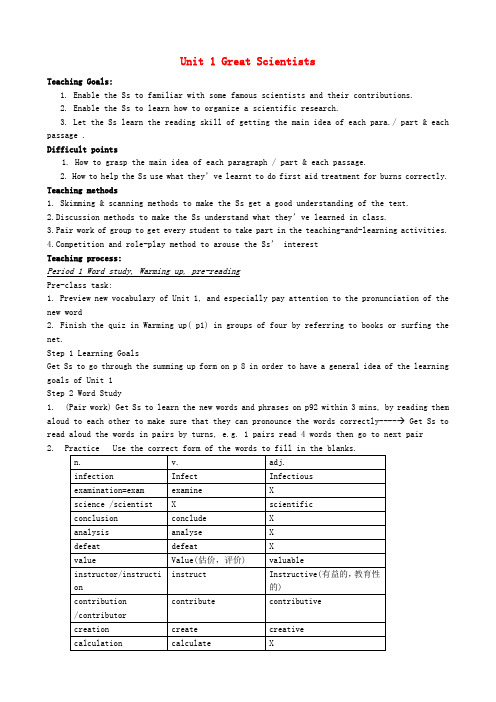
Unit 1 Great ScientistsTeaching Goals:1. Enable the Ss to familiar with some famous scientists and their contributions.2. Enable the Ss to learn how to organize a scientific research.3. Let the Ss learn the reading skill of getting the main idea of each para./ part & each passage .Difficult points1. How to grasp the main idea of each paragraph / part & each passage.2. How to help the Ss use what they’ve learnt to do first aid treatment for burns correctly. Teaching methods1. Skimming & scanning methods to make the Ss get a good understanding of the text.2.Discussion methods to make the Ss understand what they’ve learned in class.3.Pair work of group to get every student to take part in the teaching-and-learning activities.petition and role-play method to arouse the Ss’ interestTeaching process:Period 1 Word study, Warming up, pre-readingPre-class task:1. Preview new vocabulary of Unit 1, and especially pay attention to the pronunciation of the new word2. Finish the quiz in Warming up( p1) in groups of four by referring to books or surfing the net.Step 1 Learning GoalsGet Ss to go through the summing up form on p 8 in order to have a general idea of the learning goals of Unit 1Step 2 Word Study1. (Pair work) Get Ss to learn the new words and phrases on p92 within 3 mins, by reading them aloud to each other to make sure that they can pronounce the words correctly---- Get Ss to read aloud the words in pairs by turns, e.g. 1 pairs read 4 words then go to next pair2. Practice Use the correct form of the words to fill in the blanks.Step 3. Warming up (Group competition and introduce the great scientists)1.Check the answers to the quiz to find out which group know the most .2.Introduce the great scientists.1) Archimedes (287—212 BC) Ancient Greek. He was a mathematician. He found that if you put an object into water the water pushes the object up. It rises and partly floats.“Give me a place to stand on, and I can move the earth.” ----Archimedes2) Charlie Darwin(1808-1882) British naturalist. The Origin of Species was published in 1859. It explained how plants and animals had changed over time to fit in with a changing environment. His book showed that people had developed from apes.3) Gregor Mendel(1822—1884) Czech. The father of genetic. He grew pea plants and developed ideas on heredity (遗传) and inherited characteristics. Between 1856—1863 he grew 28,000 pea plants. He examined seven kinds of seed and plant characteristics and developed some laws of inheritance.4) Marie Curie ( Polish ) (1867-1934) was born in Poland, moved to Paris and studied chemistry and physics there. She married Pierre Curie and together they studied radioactive materials and discovered radium. In 1911 she received the Nobel Prize in Chemistry. Her death in 1934 was almost certainly due to radiation in her work.5) Thomas Edison(1847----1931) He was already an inventor of other electrical devices (phonograph, electric light bulb) when in 1882 he designed a system for providing New York with electricity from a central power station. This was a tremendous achievement, which had previously been thought impossible.6) Leonardo da Vinci (Italian) (1452-1519)He was a famous Italian artist whose skill for showing human skin tones made his paintings seem to come alive. He used to study dead people in order to make his paintings as accurate as possible. Some of his famous paintings include “The Adoration of the Magi” and the “The Last Supper”. Later in his life he lived in France where he designed a submarine (潜水艇) and a flying machine.7) British. He did research into different gases and discovered the medical value of nitrous oxide (laughing gas) as an anaesthetic.(麻醉药) In 1815 he developed a safety lamp for miners.8) Zhang Heng ,Chinese( 78-----139) He invented the first seismograph to indicate in the direction of an earthquake. It was in the shape of a cylinder with eight dragonheads round the top, each with a ball in its mouth. Around the bottom were eight frogs directly under a dragon’s head. When an earthquake occurred, a ball fell out of the dragon’s mouth, making a noise.9) Stephen Hawking,British(1942--- ) He has worked in astronomy and studied black holes in space. He has shown that black holes do not only absorb everything around them but, from time to time, throw out matter as well. This may mark the beginning of new galaxies. This is an advance on the old theory which said that black holes “eat” everything they come across.Step 4 Pre-reading1. (Pair work) What five most important qualities do you think a scientist should have? Give reasons.clever/talented strict patient creative determined/strong-willed positive honest energetic intelligent/hard-working ambitious careful co-operative confident brave2. (Group work) Ex2, p1Do you know how to prove a new idea in scientific research? Discuss in groups the stages in examining a new scientific idea. What order would you put them in?8)Draw a conclusion 3)Think of a method 4)Collect results 5)Make up a question 1)Find a problem 5)Analyse the results 6)find supporting evidence 7)Repeat if necessary Step 5. SummarySeeing much, suffering much, and studying much are three pillars (支柱,要素) of learning. learning without thought is a labour lost; thought without learning is perilous(危险的)3. To know the disease is half the cure. 找出病根等于医治了一半。
高中英语必修五《unit1 Great Scientists》示范说课稿

《unit1 Great Scientists》说课稿各位评委老师,上午好!我是号考生,我今天说课的题目是《unit1 Great Scientists》。
我主要从教材分析、教学方法与策略、教学过程、板书设计等几个步骤向大家详细地讲解我对这节课的安排。
一.说教材1. 教材内容本节课是人教课标版必修5第一单元的第一课时的Reading部分,是该单元的主要内容,它介绍了英国著名医生John Snow是如何通过考察、分析、探究的科学方法,发现并控制“霍乱”这种传染病的。
通过阅读课文,使学生感悟科学家的周密观察、勇于探索、认真分析的科学精神,使学生了解科学方发现的全过程具有其科学的严密性。
2. 教学目标结合单元教学要求和本课特点,充分考虑学生的年龄特点、认知水平,遂将本课的教学目标确定为:知识目标1) Get students to learn the useful new words and expressions in this part.2) Let students learn about some great scientists and their contribution.3) Have students read the passage and know about John Snow and how he defeated “King Cholera”.能力目标1) Develop students’ reading ability and let them learn different reading skills.2) Enable students to talk about great scientists and tell their stories.情感目标1) Let students learn from great scientists, stimulate their love and respect for them and develop their moral qualities.2) Develop student’s sense of cooperative learning.3. 教学重点因为本组教材的重点了解项目是“John Snow 破解King Cholera难题”,所以确定本课的教学重点是:1) Let students learn about some great scientists and their contributions.2) Get students to read the passage and know about John Snow and how he defeated “ King Cholera”.3) Have students learn different reading skills.4.教学难点考虑到学生拓展阅读能力,语言输出能力等方面还需进一步努力,所以将本课的教学难点确定为:1) Develop students’ reading ability.2) Enable students to talk about great scientists and tell their stories.3) Let students learn how to organize scientific research.二.说教法和学法1. 教学方法引导学生独立思考,合作学习,进行师生、生生互动的“任务型”教学,设计了许多易于操作的任务型活动。
重点单词(必修 5 Unit 1 Great scientists)(讲义)
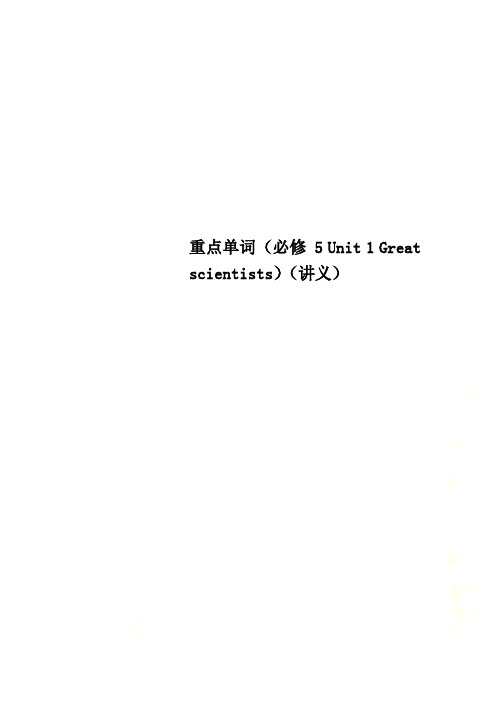
重点单词(必修 5 Unit 1 Great scientists)(讲义)高中英语重点单词(必修 5 Unit 1 Great scientists)1. 学习单词,注意重点单词的用法并灵活运用这些单词。
2. 牢记核心单词的介词搭配及其重要用法。
重点:conclude, attend, expose, absorb, blame难点:absorb的用法。
【单词学习】1. conclude vt.& vi. 断定,推断;使结束,终止;达成,缔结conclude sth. with sth. / by doing sth. 以……结束conclude sth.(from sth.) that... (从……)推断出,断定He concluded from their remarks that they were not in favour of the plan.他从他们的话语中推断出他们不赞同此项计划。
He concluded by wishing everyone a safe trip home.他讲话结束时祝愿大家回家一路平安。
conclusion n. 结论;结束draw / reach / arrive at / come to a conclusion 得出结论come to the conclusion that... 所得结论是……in conclusion 最后attend on / upon sb. 伺候某人;照顾某人attend to sb. / sth. 照顾某人/专心于处理某事He is very famous in this field, and tens of thousands of fans will attend his lecture this evening.他在这个领域很出名,今晚会有成千上万的粉丝听他的讲座。
He has to attend (on) his sick son.他不得不照顾生病的儿子。
人教版高二英语必修五 Unit 1 Great scientists 教案
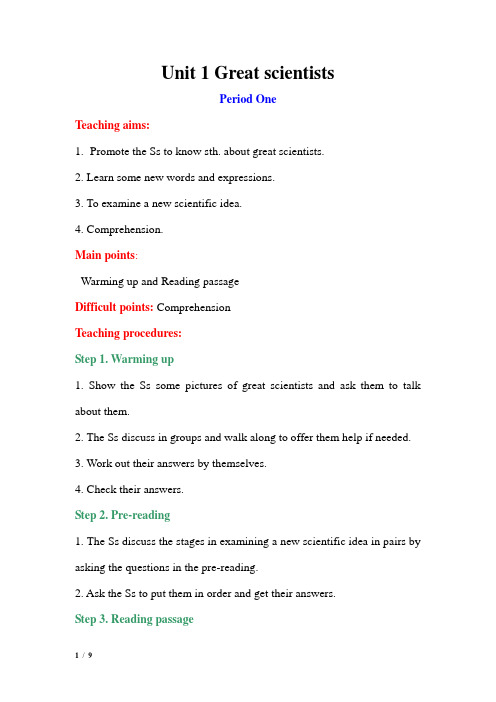
Unit 1 Great scientistsPeriod OneTeaching aims:1.Promote the Ss to know sth. about great scientists.2. Learn some new words and expressions.3. To examine a new scientific idea.4. Comprehension.Main points:Warming up and Reading passageDifficult points: ComprehensionTeaching procedures:Step 1. Warming up1. Show the Ss some pictures of great scientists and ask them to talk about them.2. The Ss discuss in groups and walk along to offer them help if needed.3. Work out their answers by themselves.4. Check their answers.Step 2. Pre-reading1. The Ss discuss the stages in examining a new scientific idea in pairs by asking the questions in the pre-reading.2. Ask the Ss to put them in order and get their answers.Step 3. Reading passage1. Let the Ss go over the passage and try to find the hard words, expressions and sentences they have.2. Explain the difficulties.3. Ask the Ss to read the passage more carefully and then try to complete the chart in the comprehending by discussing in groups.4. Choose some Ss to answer the questions in the comprehending.5. Ask the Ss to choose one of the paragraphs to read aloud fluently.Step 4. HomeworkRead the passage again and go over Learning about language.Period TwoTeaching aims and demands:1. Discover the useful words and expressions.2. Learn and improve the use of useful words and expressions.Main points:Learn to use the words and expressions that the Ss discover. Difficult points: Improve the use of the words and expressions. Teaching procedures:Step 1. Learning about language1. Discover the useful words and expressions in this unit in groups of four.2. Ask the Ss to show their results to the class.3. Ask them to study the words and expressions in Ex.1.4. Ss have a discussion and do the exercises.5. Check their answers.6. Change the verbs into nouns and make sentences by using “make a …” Step 2. Using words and expressions1. Make sure the Ss know the words and expressions.2. Let the Ss work in groups to complete the blank in Ex.1.3. Check their answers.4. Do the translations. Ss discuss the sentences and the translate them into English, using the words and phrases in brackets.Step 3. Words learning1. Show the Ss a list of prefixes to talk about them.2. Ask them to work in groups to find some words with the prefixes and study their meanings.3. Let them show their results to the class.4. Walk around the class to give them help if needed.Step 4. Study the use and meanings of suggest1. Study the meaning of suggest by looking the dictionary entry.2. Match the meanings with the sentences on the right in Ex.4.3. Check their answers.Step 5. HomeworkWrite down the translation Ex.2, 4, 6 and 7 in the exercise book.Period ThreeTeaching aims and demands:1. Discover the useful structure.2. Learn to use the grammar of past participle.3. Enable the Ss understand the past participle using as attribute and predicative.Main points:Learn the usage of the past participle using as attribute and predicative.Difficult points:Use the useful structure.Teaching procedures:Step 1. RevisionReview the past participle of some verbs.Step 2.1. Look at the chart and study the phrases.Past participle as the attribute and the predicative(1) terrified people(2) reserved seats(3) polluted water(4) a crowded room(5) a pleased winner(6) children who look astonished(7) a vase that is broken(8) a door that is closed(9) the audience who feel tired(10) an animal that is trapped3. Ask the Ss the following questions:(1) What kind of words before the past participles?(2) What kind of words after the past participles?4. Ask the Ss find the sentences using the past participle in the reading passage.5. Ss have a discussion and complete the chart with the same meaning of the phrases above.6. Ss show their results to the class.7. Complete the sentences in Ex.3.Step 3. Using structure1. Make sure the Ss know the words and the discuss in groups to finish the sentences using past participle.(Ex.1)2. Rewrite the sentences into one sentence using the past participle as the attribute or predicative.3. Check their answers.Step 4. HomeworkWrite down 1, 3, 5, 7 of Ex.2 in the exercise book.Period FourTeaching aims and demands:1. Improve the Ss listening skills.2. Know more about great scientists.Main points:Listening and speakingDifficult points:Get to know the information of listening materials. Teaching procedures:Step 1. Listening and speaking1. Listen to the tape and answer the questions.(1) What did Qian Xuesen study first?(2) What experience did he get in America that was very useful for China?(3) What was Qian Xuesen’s achievement when he returned to China from America?(4) How has he been honoured in China?(5) How did Steve honour him?Step 2. Speaking1. Ss discuss what scientific job they will do in the future in pairs by using the questions and expressions on Page 6.2. Ask some Ss to talk in class.Step 3. Listening and talking1. Play the tape for the Ss to listen and finish the exercises in the workbook, pause from time to time if needed.2. Check their answers.3. Work in pairs. Imagine you are going to meet a specialist about a newly-found flower by using the useful sentences on Page 42.Step 4. Listening task1. Play the tape for the Ss to get the information of the listening task.2. Check their answers.Step 5. HomeworkPrepare the reading task.Period FiveTeaching aims and demands:Improve the Ss reading skills and their talent in getting the information. Main points:Reading and reading taskDifficult points:Finding the Euler path.Teaching procedures:Step 1. RevisionRevise the past participle used as the attribute and predicative.Step 2. Reading1. Ss read the passage as fast as they can and then draw the two theories of the universe in groups.2. Ask the Ss to show their pictures to the class.3. Ss read the passage again and find the problems they have.4. Solve the Ss’ problems.5. Discuss in pairs. If you were Nicolaus Copernicus, would you have hidden your theory for so many years? Why?6. Choose some Ss to share their ideas to the class.Step 3. Reading task1. Ss read the passage and answer the following questions.(1) What is odd point? (2) What is even point? (3) What rule did Euler find?2. Ss discuss in groups and try to find the answers.3. Teacher walks around to offer them help.4. Use the rule to see if you can go over the diagram, not missing any points or going over any line twice.( See figures on Page 46)5. Ss work in groups.Step 4. HomeworkWrite a short passage about Copernicus.Period SixTeaching aims and demands:1. Try to write sth persuasive.2. Learn to write a report about people.Main points:Make a plan in discussion.Difficult points:Write a passage / a report.Teaching procedures:Step 1. Writing1.Ask the Ss to read the passage again and gather some information about Copernicus.2. Plan to write a letter.Step 2. Writing taskWrite a report about your scientist, his/her life, achievements and the key to his/her success.1. Before you begin to write, remember to put your information under three headings: life, achievements and key to success.2. Plan your report like the one on P47.3. Ask them to read their plans.4. Begin to write the report.Step 3. HomeworkComplete the report and write down on the exercise book.。
高中英语Unit1 Great scientists文章 哥白尼与日心说人教版必修五
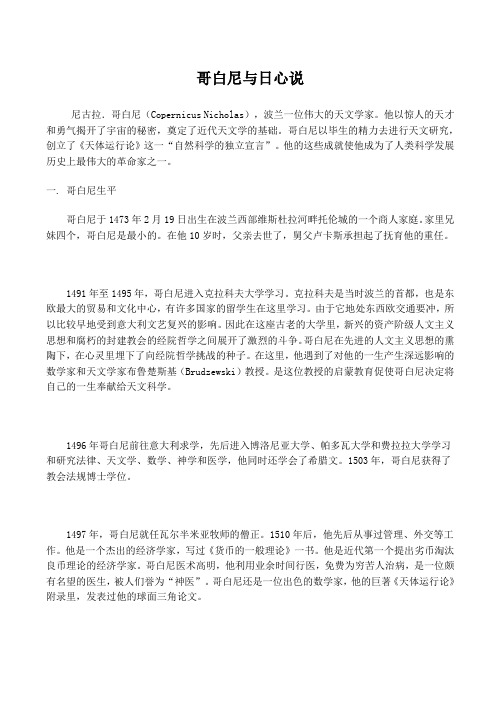
哥白尼与日心说尼古拉.哥白尼(Copernicus Nicholas),波兰一位伟大的天文学家。
他以惊人的天才和勇气揭开了宇宙的秘密,奠定了近代天文学的基础。
哥白尼以毕生的精力去进行天文研究,创立了《天体运行论》这一“自然科学的独立宣言”。
他的这些成就使他成为了人类科学发展历史上最伟大的革命家之一。
一. 哥白尼生平哥白尼于1473年2月19日出生在波兰西部维斯杜拉河畔托伦城的一个商人家庭。
家里兄妹四个,哥白尼是最小的。
在他10岁时,父亲去世了,舅父卢卡斯承担起了抚育他的重任。
1491年至1495年,哥白尼进入克拉科夫大学学习。
克拉科夫是当时波兰的首都,也是东欧最大的贸易和文化中心,有许多国家的留学生在这里学习。
由于它地处东西欧交通要冲,所以比较早地受到意大利文艺复兴的影响。
因此在这座古老的大学里,新兴的资产阶级人文主义思想和腐朽的封建教会的经院哲学之间展开了激烈的斗争。
哥白尼在先进的人文主义思想的熏陶下,在心灵里埋下了向经院哲学挑战的种子。
在这里,他遇到了对他的一生产生深远影响的数学家和天文学家布鲁楚斯基(Brudzewski)教授。
是这位教授的启蒙教育促使哥白尼决定将自己的一生奉献给天文科学。
1496年哥白尼前往意大利求学,先后进入博洛尼亚大学、帕多瓦大学和费拉拉大学学习和研究法律、天文学、数学、神学和医学,他同时还学会了希腊文。
1503年,哥白尼获得了教会法规博士学位。
1497年,哥白尼就任瓦尔半米亚牧师的僧正。
1510年后,他先后从事过管理、外交等工作。
他是一个杰出的经济学家,写过《货币的一般理论》一书。
他是近代第一个提出劣币淘汰良币理论的经济学家。
哥白尼医术高明,他利用业余时间行医,免费为穷苦人治病,是一位颇有名望的医生,被人们誉为“神医”。
哥白尼还是一位出色的数学家,他的巨著《天体运行论》附录里,发表过他的球面三角论文。
哥白尼也是一位伟大的爱国主义者,当条顿骑士团疯狂侵略波兰时,他挺身而出,起来保卫自己的祖国。
高二人教新课标版必修五课件Unit 1 Great scientists Great scientists

It begins in the stomach and a severe case can lead to death without immediate treatment. And the victims died very quickly from a loss of liquid after severe vomiting (呕吐) and dn Think of a method Collect results Make a question Find a problem Analyse the results Find supporting evidence
1 Find a problem 2 Make a question 3 Think of a method 4 Collect results 5 Analyse the results 6 Find supporting evidence 7 Draw a conclusion
They were instructed not to expose people to polluted water anymore.
Comprehending 1 Read the passage and number these events in the order that they happened. 1. An outbreak of cholera hit London in 1854. 2. John Snow began to test two theories. 3. John Snow investigated two streets where the outbreak was very severe. 4. John Snow marked the deaths on a map.
高二英语必修五《Unit 1 Great scientists》教案新

高二英语必修五《Unit 1 Great scientists》教案【前言】增加内驱力,从思想上重视高二,从心理上强化高二,使战胜高考的这个关键环节过硬起来,是“志存高远”这四个字在高二年级的全部解释。
我高二频道为正在拼搏的你整理了《高二英语必修五《Unit 1 Great scientists》教案》盼望你喜爱!教案【一】教学预备教学目标1.Students learn some new words and expressions to describe people ,especially famous persons;2.Students are encouraged to give more information about famous persons who they are familiar:3. Students can realize that it is scientific spirit that makes those scientists successful.教学重难点1. Words and expressions in this unit2. Previous knowledge of some of the famous scientists3. Comprehending the text教学过程【导入】Words learning(Students are assigned to learn the new words of this unit and find out the English explainations of the new words )Definitions or explanationsA.examine 1.general principles of an art or scienceB.repeat 2.say or do againC.theory 3.at once; without delayD.immediate 4.look at...carefully in order to learn about or from...plete 5.of great value, worth or useF.valuable 6.having all its parts; whole; finishedG.announce 7.make knownH.control e or bring to an endI.positive 9.power to order or directJ.conclude 10.quite certain or sure【讲授】useful sentences learning(The sentences are picked from the text.)1.“All roads lead to Rome, ”he encouraged me after I failed the entrance examination.2.This sentence doesn’t make any sense.3.Our English teacher is not only strict with us but also friendly to us.4.He is good-looking, apart from his nose.5.It is announced that the spacecraft, Shenzhou Ⅵ, landed on the earth successfully.6.It is not Tom but you who are to blame.7.In 1995, the Chinese government put forward a planfor“rejuvenating the nation by relying on science and education”.And it has helped Chinese scientists make many breakthroughs.8.Have you drawn any conclusion after you read this passage?9.Well done.So much for the learning of the new words and expressions.【讲授】Introduction of a classic articleTeacher introduce a famous person --Qian Xuesen and students learn to write an article about the famous scientis using the words and expressions they just learn in class.【活动】Share the outcomeStudents share their article orally and discuss whether they have used some good and advanced expressions.【练习】Consolidation完成句子(1)爱因斯坦被认为是二十世纪最宏大的科学家之一。
高二英语必修五《Unit 1 Great scientists》教案设计
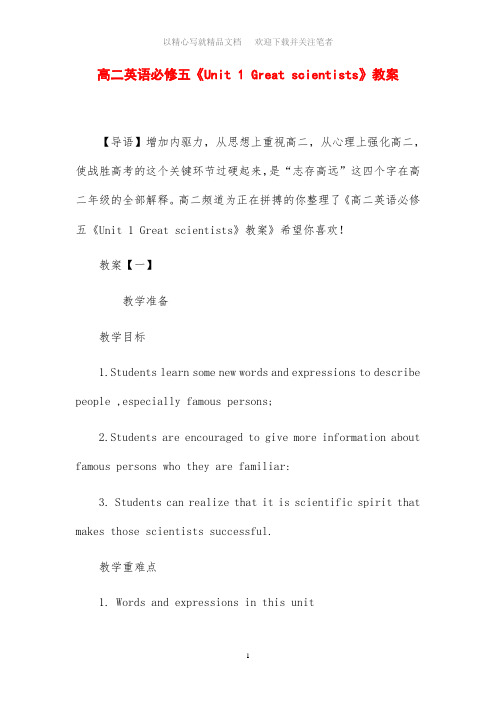
高二英语必修五《Unit 1 Great scientists》教案【导语】增加内驱力,从思想上重视高二,从心理上强化高二,使战胜高考的这个关键环节过硬起来,是“志存高远”这四个字在高二年级的全部解释。
高二频道为正在拼搏的你整理了《高二英语必修五《Unit 1 Great scientists》教案》希望你喜欢!教案【一】教学准备教学目标1.Students learn some new words and expressions to describe people ,especially famous persons;2.Students are encouraged to give more information about famous persons who they are familiar:3. Students can realize that it is scientific spirit that makes those scientists successful.教学重难点1. Words and expressions in this unit2. Previous knowledge of some of the famous scientists3. Comprehending the text教学过程【导入】Words learning(Students are assigned to learn the new words of this unit and find out the English explainations of the new words ) Definitions or explanationsA.examine 1.general principles of an art or scienceB.repeat 2.say or do againC.theory 3.at once; without delayD.immediate 4.look at...carefully in order to learn about or from...plete 5.of great value, worth or useF.valuable 6.having all its parts; whole; finishedG.announce 7.make knownH.control e or bring to an endI.positive 9.power to order or directJ.conclude 10.quite certain or sure【讲授】useful sentences learning(The sentences are picked from the text.)1.“All roads lead to Rome, ”he encouraged me after I failed the entrance examination.2.This sentence doesn’t make any sense.3.Our English teacher is not only strict with us but also friendly to us.4.He is good-looking, apart from his nose.5.It is announced that the spacecraft, Shenzhou Ⅵ, landed on the earth successfully.6.It is not Tom but you who are to blame.7.In 1995, the Chinese government put forward a plan for“rejuvenating the nation by relying on science and education”.And it has helped Chinese scientists make many breakthroughs.8.Have you drawn any conclusion after you read this passage?9.Well done.So much for the learning of the new words and expressions.【讲授】Introduction of a classic articleTeacher introduce a famous person --Qian Xuesen and students learn to write an article about the famous scientis using the words and expressions they just learn in class.【活动】Share the outcomeStudents share their article orally and discuss whether they have used some good and advanced expressions.【练习】Consolidation完成句子(1)爱因斯坦被认为是二十世纪最伟大的科学家之一。
人教版 高中英语必修五:Unit1 Great scientists

Great scientists
Reading
Pre-reading
1.What impresses you most in 2003?
Which person impresses you most during the SARS?
What other infectious diseases do you know?
no wayຫໍສະໝຸດ (俚语)没门, 别想feel one’s way
摸黑走, 谨慎从事
on one’s way to… 在去…的路上
in this way=by this means=with this method 用这种方法
2.Who put forward a theory about black holes?
I don’t like the way __(_th__a_t/_i_n__w_h_i_c_h_) you
speak to your father. 我不喜欢你跟你父亲讲话的方式.
与way相关的短语:
by the way
顺便说
by way of … lose one’s way
通过…的方法 迷路
2. Who wrote a book
explaining how animals
and plants developed as
the environment changed? Charles Darwin (1808-1882) British author of The Origin of Species
C.He got interested in two theories that possibly explained how cholerakilled people
人教版高中英语必修五Unit 1 Great scientists 1.1
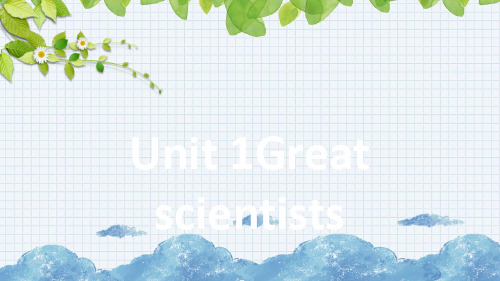
Section Ⅰ Warming Up,Pre-
一二三 四五
一、词义匹配
A
B
1.suspect a.to tell people something about a decision,plans,etc.
2.blame b.to deal with a situation,or a person
Unit 1Great scientists
【文章导语】 Have you heard of Newton,a famous scientist?There are many interesting stories about him.Here is one.
你听说过著名科学家牛顿吗?关于他,有许多有趣的故事。下面 就是其中之一。
adj.受污染的
一二三 四五
四、阅读课文JOHN SNOW DEFEATS “KING CHOLERA”,回
答下列问题
1.According to John Snow’s view,
.
A.Queen Victoria suffered a lot from bad health
B.a cure had been found for cholera before his time
C.cholera’s cause had to be discovered in order to control it
D.thousands of terrified people knew what they should do
答案:C
一二三 四五
2.Which of the following theories did John Snow believe in?
必修5_unit1_Great_Scientists

The results
He found the cause of cholera was the polluted water
Idea 1 or 2? Why? Idea 2. Because the information showed that the dirty water carried cholera
3. No. The map helped John Snow organise his ideas. He was able to identify those households that had had many deaths and check their water-drinking habits. He identified those houses that had had no deaths and surveyed their drinking habits. The evidence clearly pointed to the polluted water being the cause.
Read the passage again and fill in the blanks: (in 5
John
Snow
was
a
well-known
d_o_c_t_orin
minutes) London in the
_19_t_h century. He wanted to find the _c_a_u_s_e_ of cholera in order to _d_e_f_e_a_t it. In 1854 when a
3.Who invented the first steam engine?
A. Thomas Newcomen B. Archimedes C. Thomas Edison
人教版高二英语必修5unit1_Great_Scientists Reading课件(共22张PPT)

Careful Reading:
1.What did he do with the results of his enquiry? Marked on a map…
2.What valuable clue did he get about the cause of the disease? Many of the deaths… …had no deaths. 3.What might be the cause? the water was to blame for cholera.
Marie Curie
Who invented the way of giving electricity to everybody I large cities?
Thomas Edison
Warming up:
7. Who was the painter that studied dead bodies to improve his painting of people?
Careful Reading:
Find the main idea of each paragraph:
1. 2.
3.
4.
5.
6. 7.
The causes of cholera The correct or possible theory Collect data on those where people were ill and died and where they got their water Plot information on a map to find out where people died or did not die Analyse the water to see if that is the cause of the illness. Find other evidences to confirm his conclusion The polluted dirty source of drinking water was to blame for the cause of the London cholera.
高中英语人教必修五unit1GreatScientists全单元优质教案
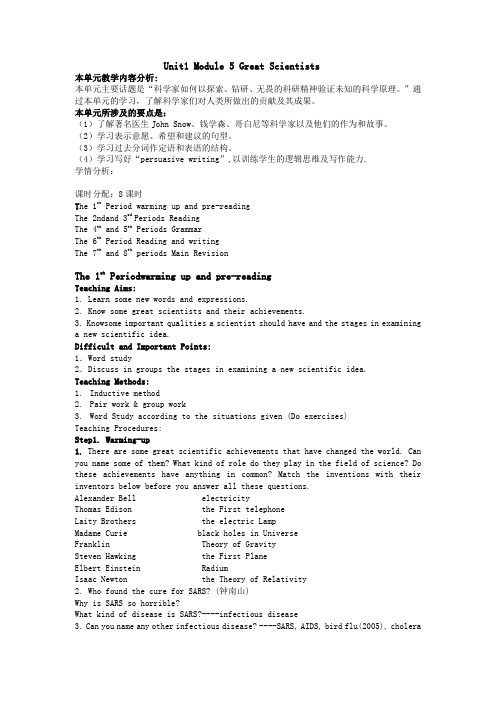
Unit1 Module 5 Great Scientists本单元教学内容分析:本单元主要话题是“科学家如何以探索、钻研、无畏的科研精神验证未知的科学原理。
”通过本单元的学习,了解科学家们对人类所做出的贡献及其成果。
本单元所涉及的要点是:(1)了解著名医生John Snow、钱学森、哥白尼等科学家以及他们的作为和故事。
(2)学习表示意愿、希望和建议的句型。
(3)学习过去分词作定语和表语的结构。
(4)学习写好“persuasive writing”,以训练学生的逻辑思维及写作能力.学情分析:课时分配:8课时T he 1st Period warming up and pre-readingThe 2ndand 3rd Periods ReadingThe 4th and 5th Periods GrammarThe 6th Period Reading and writingThe 7th and 8th periods Main RevisionThe 1st Periodwarming up and pre-readingTeaching Aims:1. Learn some new words and expressions.2. Know some great scientists and their achievements.3. Knowsome important qualities a scientist should have and the stages in examininga new scientific idea.Difficult and Important Points:1.Word study2.Discuss in groups the stages in examining a new scientific idea.Teaching Methods:1.Inductive method2.Pair work & group work3.Word Study according to the situations given (Do exercises)Teaching Procedures:Step1. Warming-up1. There are some great scientific achievements that have changed the world. Can you name some of them? What kind of role do they play in the field of science? Do these achievements have anything in common? Match the inventions with their inventors below before you answer all these questions.Alexander Bell electricityThomas Edison the First telephoneLaity Brothers the electric LampMadame Curie black holes in UniverseFranklin Theory of GravitySteven Hawking the First PlaneElbert Einstein RadiumIsaac Newton the Theory of Relativity2. Who found the cure for SARS? (钟南山)Why is SARS so horrible?What kind of disease is SARS?----infectious disease3. Can you name any other infectious disease? ----SARS, AIDS, bird flu(2005), choleraH1N1,HFMD(手足口病)Step2. Pre-reading1. Cholera may be rare nowadays except in some poor areas, but back in the 1830s-1840s, it was probably No.1 killer in the world. There were four outbreaks of cholera in the 1830s and 1840s, which killed many thousands of people in the industrial cities of England. In 1854 on August 31st “the most terrible outbreak of cholera which ever occurred in the kingdom” began. It was so violent and sudden that 127 people around Broad Street died in the first three days. And then a famous physician John Snow discovered the source of the disease and since then Cholera was finally brought under control.2. How did he solve the problem of cholera? Actually, he followed a scientific procedure to carry out his scientific research. The whole procedure is made up of 7 steps. Can you put them in a right order?Draw a conclusion Think of a method Collect results Make up a question Find a problem Analyze the results Repeat if necessaryStep 3 SummaryStep 4 Homework Assignment1.Read the passage John Snow Defeats “King Cholera”.2. Learn the new words by heart and prepare for tomorrow’s dictation.课后反思:The 2ndand 3rd Periods ReadingTeaching aims:1. Learn some new words and expressions.2. Improve the students’ reading skills.3. Know how to prove a new idea in scientific research.Difficult and Important Points:(1)Reading comprehension(2)What did John Snow do to prove a new idea in scientific research?Teaching Methods:1. Group work2. Competition3. Illustration4. Deductive MethodTeaching Procedures:Step 1Lead inBackground introduction to John SnowJohn Snow (1813-1858) was born and worked as a doctor in Great Britain. He was originally an anesthetist(麻醉师).He was so famous that he became the doctor for Queen Victoria at the births of her many children.Four outbreaks of cholera in the 1830s and 1840s killed many people in England. In 1854, “the most terrible outbreak of cholera which ever occurred in the kingdom” began. It was so violent and sudden that 127people died in the first three days. Step 2 Skimming and ScanningMore questions are given to get the general ideas of this passage and some obvious facts.Who defeats “King Cholera“? John SnowWhat happened in 1854? Cholera outbreak hit London.How many people died in 10 days? 500Why is there no death at No. 20 and 21 Broad Street as well as at No. 8 and 9 Cambridge Street?These families had not drunk the water from the Broad Street pump.Step 3 Reading for details1. Why couldn’t the cholera be under control at first?Neither its cause, not its cure was understood.2. Which theory did John Snow believe in?People absorbed cholera into their bodies with their meals.3. John Snow finally proved the theory he believed by ________.gathering information with the help of a maplooking into the source of the water for Broad Street and Cambridge Street Separating those who suffered cholera from those who didn’tBoth A and B (right choice)4. To prevent the cholera from spreading again, what did John Snow do? Suggested that the source of all water supplies be examine. Suggested that new methods of dealing with polluted water be found. Instructed the water companies not to expose people to the polluted water anymore.Step 4 Summing up: Read the passage silently and quickly and match the stages ofThe same with above:Find a problem draw a conclusion Think of a method Collect results Make up a question Analyze the results Repeat if necessaryParagraph 1: Introduction of John Snow and CholeraParagraph 2: Two theoryParagraph 3-5: Study of the breakout in 1854Paragraph 3: Think of a method: Test two theoryCollect the result: Mark the deathAnalyze the result: Reason for death and no deathParagraph 4: Analyze the result: Find the resource of the waterParagraph 5: Repeat if necessary: Find more evidence.Draw a conclusion: Cholera was spread by germPolluted water carried cholera Paragraph 6: Prevention of CholeraStep 5 Retell the passage (文章缩写仅供参考)Provide ss with a summary with some blanks. Let them retell the passage as well as pay attention to some important words.Read the passage again and fill in the blanks:John Snow was a well-known ____ in London in the ___ century. He wanted to find the ______ of cholera in order to ______ it. In 1854 when a cholera ____ out, he began to gather information. He _____ on a map where all the dead people had lived and he found that many people who had drunk the dirty water from the ______ died. Sohe decided that the polluted water carried cholera. He suggested that the _____ of all water supply be _______ and new methods of ________ with polluted water be found. Finally, “King Cholera” was defeated.Key: (见课文和教师用书)Step 6Language learning1.So many thousands of terrified people died every time there was an outbreak. 每当(疾病)突发时,总有成千的人死去【句型剖析】 1)本句是一个复合句,every time引导的是一个时间状语从句,意思是“每当……”,相当于“when”。
高中英语Unit 1 Great scientists 人教版必修五
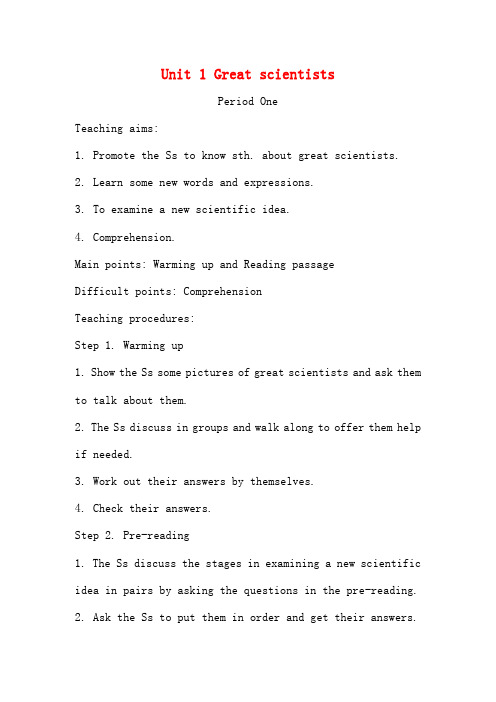
Unit 1 Great scientistsPeriod OneTeaching aims:1. Promote the Ss to know sth. about great scientists.2. Learn some new words and expressions.3. To examine a new scientific idea.4. Comprehension.Main points: Warming up and Reading passageDifficult points: ComprehensionTeaching procedures:Step 1. Warming up1. Show the Ss some pictures of great scientists and ask them to talk about them.2. The Ss discuss in groups and walk along to offer them help if needed.3. Work out their answers by themselves.4. Check their answers.Step 2. Pre-reading1. The Ss discuss the stages in examining a new scientific idea in pairs by asking the questions in the pre-reading.2. Ask the Ss to put them in order and get their answers.Step 3. Reading passage1. Let the Ss go over the passage and try to find the hard words, expressions and sentences they have.2. Explain the difficulties.3. Ask the Ss to read the passage more carefully and then try to complete the chart in the comprehending by discussing in groups.4. Choose some Ss to answer the questions in the comprehending.5. Ask the Ss to choose one of the paragraphs to read aloud fluently.Step 4. HomeworkRead the passage again and go over Learning about language.Period TwoTeaching aims and demands:1. Discover the useful words and expressions.2. Learn and improve the use of useful words and expressions. Main points: Learn to use the words and expressions that the Ss discover.Difficult points: Improve the use of the words and expressions.Teaching procedures:Step 1. Learning about language1. Discover the useful words and expressions in this unit in groups of four.2. Ask the Ss to show their results to the class.3. Ask them to study the words and expressions in Ex.1.4. Ss have a discussion and do the exercises.5. Check their answers.6. Change the verbs into nouns and make sentences by using “make a …”Step 2. Using words and expressions1. Make sure the Ss know the words and expressions.2. Let the Ss work in groups to complete the blank in Ex.1.3. Check their answers.4. Do the translations. Ss discuss the sentences and thebrackets.Step 3. Words learning1. Show the Ss a list of prefixes to talk about them.2. Ask them to work in groups to find some words with the prefixes and study their meanings.3. Let them show their results to the class.4. Walk around the class to give them help if needed. Step 4. Study the use and meanings of suggest1. Study the meaning of suggest by looking the dictionary entry.2. Match the meanings with the sentences on the right in Ex.4.3. Check their answers.Step 5. HomeworkWrite down the translation Ex.2, 4, 6 and 7 in the exercise book.Period ThreeTeaching aims and demands:1. Discover the useful structure.2. Learn to use the grammar of past participle.3. Enable the Ss understand the past participle using as attribute and predicative.Main points: Learn the usage of the past participle using as attribute and predicative.Difficult points: Use the useful structure.Teaching procedures:Step 1. RevisionReview the past participle of some verbs.Step 2.1. Look at the chart and study the phrases.Past participle as the attribute and the predicative(1) terrified people(2) reserved seats(3) polluted water(4) a crowded room(5) a pleased winner(6) children who look astonished(7) a vase that is broken(8) a door that is closed(9) the audience who feel tired(10) an animal that is trapped3. Ask the Ss the following questions:(1) What kind of words before the past participles?(2) What kind of words after the past participles?4. Ask the Ss find the sentences using the past participle in the reading passage.5. Ss have a discussion and complete the chart with the same meaning of the phrases above.6. Ss show their results to the class.7. Complete the sentences in Ex.3.Step 3. Using structure1. Make sure the Ss know the words and the discuss in groups to finish the sentences using past participle.(Ex.1)2. Rewrite the sentences into one sentence using the past participle as the attribute or predicative.3. Check their answers.Step 4. HomeworkWrite down 1, 3, 5, 7 of Ex.2 in the exercise book.Period FourTeaching aims and demands:1. Improve the Ss listening skills.2. Know more about great scientists.Main points: Listening and speakingDifficult points: Get to know the information of listening materials.Teaching procedures:Step 1. Listening and speaking1. Listen to the tape and answer the questions.(1) What did Qian Xuesen study first?(2) What experience did he get in America that was very useful for China?(3) What was Qian Xuesen’s achievement when he returned to China from America?(4) How has he been honoured in China?(5) How did Steve honour him?Step 2. Speaking1. Ss discuss what scientific job they will do in the future in pairs by using the questions and expressions on Page 6.2. Ask some Ss to talk in class.Step 3. Listening and talking1. Play the tape for the Ss to listen and finish the exercises in the workbook, pause from time to time if needed.2. Check their answers.3. Work in pairs. Imagine you are going to meet a specialist about a newly-found flower by using the useful sentences on Page 42.Step 4. Listening task1. Play the tape for the Ss to get the information of the listening task.2. Check their answers.Step 5. HomeworkPrepare the reading task.Period FiveTeaching aims and demands:Improve the Ss reading skills and their talent in getting the information.Main points: Reading and reading taskDifficult points: Finding the Euler path.Teaching procedures:Step 1. RevisionRevise the past participle used as the attribute and predicative.Step 2. Reading1. Ss read the passage as fast as they can and then draw the two theories of the universe in groups.2. Ask the Ss to show their pictures to the class.3. Ss read the passage again and find the problems they have.4. Solve the Ss’ problems.5. Discuss in pairs. If you were Nicolaus Copernicus, wouldyou have hidden your theory for so many years? Why?6. Choose some Ss to share their ideas to the class.Step 3. Reading task1. Ss read the passage and answer the following questions.(1) What is odd point? (2) What is even point? (3) What rule did Euler find?2. Ss discuss in groups and try to find the answers.3. Teacher walks around to offer them help.4. Use the rule to see if you can go over the diagram, not missing any points or going over any line twice.( See figures on Page 46)5. Ss work in groups.Step 4. HomeworkWrite a short passage about Copernicus.Period SixTeaching aims and demands:1. Try to write sth persuasive.2. Learn to write a report about people.Main points:Make a plan in discussion.Difficult points:Write a passage / a report.Teaching procedures:Step 1. Writing1.Ask the Ss to read the passage again and gather some information about Copernicus.2. Plan to write a letter.Step 2. Writing taskWrite a report about your scientist, his/her life, achievements and the key to his/her success.1. Before you begin to write, remember to put your information under three headings: life, achievements and key to success.2. Plan your report like the one on P47.3. Ask them to read their plans.4. Begin to write the report.Step 3. HomeworkComplete the report and write down on the exercise book.。
- 1、下载文档前请自行甄别文档内容的完整性,平台不提供额外的编辑、内容补充、找答案等附加服务。
- 2、"仅部分预览"的文档,不可在线预览部分如存在完整性等问题,可反馈申请退款(可完整预览的文档不适用该条件!)。
- 3、如文档侵犯您的权益,请联系客服反馈,我们会尽快为您处理(人工客服工作时间:9:00-18:30)。
characteristic n.特征;特性adj. 独特的 _____________
⑴ We are building socialism with Chinese ______________ characteristics (character).
~a meeting , ~a ceremony, ~a funeral, ~ a wedding, ~ a lecture(听讲座), ~ concert(听音乐会) ~school(上学), ~church(上教堂)
拓展:attend to sth. 注意,专心
* Attend to your work and stop talking. 专心工作, 不要说话
3.--so famous, expert, indeed, that he attended Queen Victoria as….. 1) attend (on) sb.照顾,护理 Which doctor is attending (on) you? 2) attend sth.出席, 参加
5. … people absorbed this disease into their bodies with their meals. absorb v. 吸收
Use the cloth to absorb the spilled ink. 吸干撒的墨水
Black cloth absorbs light.
join 加入(团体,组织,参军)、 参加(某些小型活动) join in take part in 参加(某些大型活动) 参加(会议,课程,婚礼) attend
join in your discussion? May I _______ attend his classes. He was ill so he didn't________ joined His brother________ the army two years ago. took part in A lot of college students ____________sports meeting last year.
(1) 有很多人出席了会议。 The meeting was well _______. attended (2) 如果你工作不专心,你就不会成功。 attend to your work, you won't succeed. If you don't________
(3) 珍多年来一直在照料她那有病的母亲。 attending on her sick mother for years Jane have been __________
4. … when he thought about helping ordinary people exposed to cholera. 1)expose 暴露, 显露 When he smiled he exposed a set of perfect white teeth. expose …to…把……暴露于……之下.
be absorbed in… 专注于,被吸引;
I was absorbed in a book and didn’t hear your call.
absorbed in 1.Simon was so __________ (沉浸于)his book that he didn’t even notice me come in.
⑵ The government is finding a cure _____ for the rising housing prices.
4. suspect vt. 怀疑;n.嫌疑犯;adj.不可靠的
suspect sb.of ....认为某人有……的嫌疑
运用:用适当的词填空或用所给词的适当形 式填空。 ⑴ He is suspected ____ of murder.
⑵ Nowadays,something must be done to reduce air________ pollution (pollute).
⑶ The _________ polluter (pollute) that has polluted the river is a chemical factory.
What can you conclude from what he said?
二、翻译下列句子。 1. 从事实中得出结论很重要。
_________________________________ 2.她以一个有趣的故事结束谈话。 She concluded her talk with a funny story. _________________________________
I Mom blamed Tom for the broken glass. 2.因为和弟弟打架,大家都责备这个男孩。 blamed the boy ___ for fighting with his brother. Everyone _______
I don’t know who _______ was to blame for the car accident. I think _____________________( the driver was to blame 司机是罪魁祸首). He should have been more careful.
⑵ What made you suspect her ___ of having
taken the money?
辨析:suspected that... 表示“怀疑其有”; doubt that...“无把握,不相信”,怀疑其无。
请比较: Old friends and old wines are best. 陈酒味醇, 老友情深。 I doubt that he has stolen my watch. 我不相信他偷了我的手表。 I suspect that he has stolen my watch. 我怀疑/猜想他偷了我的手表。
expose oneself to…
• expose his skin to the sun • expose the baby to the wind and rain • expose soldiers to unnecessary risks
be exposed to 暴露; 遭受到
• 2)揭露; 揭发; 使爆光 • expose crime/ scandal/ a plot/ a project/ a plan等 • 揭露罪行﹑丑闻、阴谋﹑方案﹑计划等
⑵ He finished a novel with 2 million Chinese ___________(character). characters ⑶ He is firm in __________ character (character).
2.pollute vt. 污染;弄脏 pollution ______________ n.污染 polluted ⑴ We can’t drink the _____________ (pollute) water.
expose Many girls like to ________
to the sun in summer. themselves __ Many girls like to be ____________ exposed to the sun in summer.
_____ to sunlight for too much time will do harm to one’s skin. A. Exposed C. Being exposed B. Exposing D. Having exposed
词汇拓展: put forward
up down out off on up with away
举起; 建造; 张贴
记下,放下 扑灭 推迟,延期 穿上 忍受 收拾
put
put forward at the 1.The plan that you _____________ meeting is wonderful. 2.Many tall buildings were ________ put up along the road. put out 3.Firefighters have been called to _______ the fire in the city centre. put up with 4. I don't know how his parents__________ his behavior. put off until tomorrow 5.Don’t _________ what can be done today. ---Benjamin Franklin
3. cure v. 治愈,治疗;n. 治愈,疗法 cure sb.of sth.治好某人的疾病
a cure for ... 治疗……的方法/药物
运用:用适当的词填空或用所给词的适当形 式填空。 ⑴ Her son was addicted to the computer games and she had to spend much time ________(cure) him______the bad habits. curing of
★ Who is ___ the fire in the kitchen? A. to blame for B. to blame C. blame for D. blame
7. · · · two other deaths that were linked to the Broad Street outbreak
